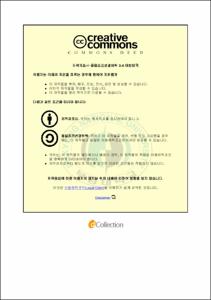신축성 필름용 전극형성을 위한 스크린인쇄용 Carbon Paste의 제조 및 물성 연구
- Abstract
- A study of Carbon paste for elastomer film electrode on Screen Printing type Manufacture and Properties
Ho Sang Lee
Dept. of Printing Engineering, Graduate School,
Pukyong National University
Abstract
For an alternative method technology of the etching method and the vapor deposition, the technology of the printed electronics is used in various fields such as a display, a semiconductor and RFID.
The printing method has many advantages which existing methods don’t have like the possibility of patterns of a thin film, forming the micro patterns, increasing the productivity and decreasing the toxic substance by the continuous production of the product.
Therefore, the industry of the printed element is highly growing. The contact formation through a method of a screen printing forms the thick film compared to other printing methods and can do the printing process continuously. The conductive paste which is used in the printing method shows shear thining and the characteristic of the paste rheology can be the standard to evaluate the paste.
In this paper, the researched conductivity carbon paste is made for the screen printing and its purpose is to make the carbon paste which has the excellent conductivity and adhesion for the flexible film which is used for Haptic Actuator. Also, another goal is that the printing film is not taken off and to play a role as the electrode when the modification of the film occurs.
As the way to evaluate, the state of paste was evaluated when viscosity, G′ (storage modulus) and G″ (loss modulus) were printed using Rheometer and according to the ratio of the dispersant, how the electrical conductivity and the adhesion change was also evaluated through testing the adhesion and the electrical conductivity using the dispersant. Also, when doing the screen printing in accordance with the size, the form and the characteristic of the particle of powder, the flow characteristic, and the weatherproof and the conductivity which can be gained after the dehydrating process were evaluated.
- Issued Date
- 2014
- Awarded Date
- 2014. 8
- Type
- Dissertation
- Publisher
- 부경대학교
- Affiliation
- 대학원
- Department
- 대학원 인쇄공학과
- Advisor
- 남수용
- Table Of Contents
- 목 차
목차 ⅰ
List of figures ⅳ
List of tables ⅵ
Abstract ⅶ
Ⅰ. 서 론 1
Ⅱ. 이 론 4
1. 전도성 카본블랙 4
2. 전도성 파우더의 전도성 발현 패스 7
3. 입자 분산 기술 8
가. 안료 입자의 분산 이론 8
나. 안료의 분산과 상호작용 11
다. 카본 파우더의 분산 12
4. 레올로지 13
가. 점도 13
나. 점탄성 15
다. 요변성 (Thixotropy) 17
5. 스크린 인쇄 기술 19
6. 전도성 페이스트 22
가. 전도성 필러(Conductive filler) 24
나. 바인더(Binder) 25
다. Percolation point와 percolation curve 25
Ⅲ. 실 험 27
1. 카본 페이스트 27
가. 재료 27
나. 실험방법 29
(1) 카본 페이스트의 구성 29
(2) 인쇄피막의 접착력 시험 32
(3) 카본 페이스트의 제조 방법 33
(3) 스크린 인쇄 조건 및 건조조건 34
다. 측정 및 분석 35
Ⅳ. 결과 및 고찰 36
1. 접착력 시험 (3M 610 tape) 36
가. 분산제의 종류에 따른 접착력시험 (XC-72) 36
나. Binder 의 증가량에 따른 접착력시험 (XC-72) 37
다. Carbon의 종류에 따른 접착력시험 (XC-72, MAX) 37
라. 분산제양의 증가에 의한 접착력의 차이 (MAX) 38
2. 레오로지 특성 분석 39
가. 분산제의 종류에 따른 레오로지 특성 분석 (XC-72) 39
나. 바인더 증가량에 따른 레오로지 특성 분석 (XC-72) 41
다. Carbon의 종류에 따른 레오로지 특성 분석 (XC-72, MAX) 43
다. 분산제 양의 증가에 따른 레오로지 특성 분석 (MAX) 45
3. 전도성 특성 분석 47
Ⅴ. 결 론 49
참고문헌 51
- Degree
- Master
- Files in This Item:
-
-
Download
 신축성 필름용 전극형성을 위한 스크린인쇄용 Carbon Paste의 제조 및 물성 연구.pdf
기타 데이터 / 2.6 MB / Adobe PDF
신축성 필름용 전극형성을 위한 스크린인쇄용 Carbon Paste의 제조 및 물성 연구.pdf
기타 데이터 / 2.6 MB / Adobe PDF
-
Items in Repository are protected by copyright, with all rights reserved, unless otherwise indicated.